
Setouchi International Art Festival begins
The Setouchi International Art Festival, which attracts the world's attention, will be held on July 7 (Sea Day) to October 19 (Sunday) for 10 days on seven islands in the Seto Inland Sea and around Takamatsu Port.
These seven islands are Megijima (Onigashima), Ogijima and Oshima, which are off the coast of Takamatsu City. Olive Island and Shodoshima, the largest island in Kagawa Prefecture, Teshima floating off the coast, Inujima Island belonging to Okayama Prefecture, and Naoshima, an island of art.
This time, we will visit Naoshima, the center of the Setouchi International Art Festival, and introduce unique souvenirs and shops.
An island of gentle people

Approximately 50 minutes by ferry from Takamatsu Port, 13 km north of Takamatsu City, Naoshima is located in Bisan Seto between Okayama and Kagawa.
Precisely in the center of 27 archipelagos, it is said that the name of Emperor Sotoku, who was defeated by the rebellion of Homoto, was named after the innocence of the islanders. As the legend suggests, the gateway to the island where gentle and welcoming people greet is Naoshima, a sea station. Ferries from Takamatsu Port and Uno Port in Okayama Prefecture and municipal buses around the island depart and arrive.
This bus has bus stops all over the island, and each ride is as easy as 1 yen (pay when you get off). (To the museum area, a municipal bus runs to "Atsuji-so" and then transfer to the Benesse free shuttle bus.)
Inquiry for regular route Shikoku Kisen Co., Ltd. Miyaura Sales Office Phone 087-892-3104
Sea Station Naoshima
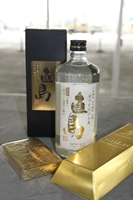


At the seaside station "Naoshima", there is also a sales counter for boarding tickets, a tourist association office and town information desk, "Cafe Ougiya" where you can enjoy authentic latte and snacks, and a rental bicycle (limited number).
The island's souvenirs line up at Naoshima Rakuichi (9: 18-XNUMX: XNUMX). Particularly noticeable are the corners of gold produced on the island, the sun salt specially produced by Naoshima, sweets using this salt, and the corners of Shodoshima such as olive products. The sale of rice harvested on the island, salt ice, Seto Inland Sea all-purpose vinegar and grilled meat sauce are also very popular, so you can come across a variety of island flavors.
Island sweets
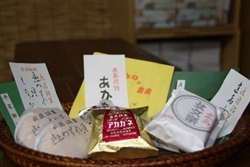
The island's famous confections, which are also located at this seaside station, are a number of Iwata-Confidential sweets. "Akagane Manju" is named after its copper smelted on the island. Naoshima Jobunraku, a sweet anko wrapped in elegant leather, is in the middle of a bunraku troupe by a woman who is unique to Naoshima.
In addition, "Koiwasarekai" is in the middle of shaping the shape of a seashell associated with a waka written by Emperor Sotoku, and its beautiful appearance and taste are very popular.
The best seaweed (seaweed) from the father's sea

Ogiya (Tateishi Fisheries), which also operates a cafe at the sea station, has been producing seaweed for generations. Of course, my main job is aquaculture even now. Despite the Seto Inland Sea, in mid-winter, it enters the sea of extreme cold, trembling and cultivating laver. This time, the seaweed is processed into delicious products by ourselves and sold at sea stations. He says, "I am cultivating it myself, so I use the finest seaweed that I can get. As the words imply, the taste is full of nutritious crispy texture. The scent of the sea spreads comfortably. We also recommend the seasoned laver called "Oyaji no Umi" and "Shionori". There is also nori tsukudani with gold leaf. By the way, the song entitled “Oyaji no Umi” is based on a song written by Mr. Kenyoshi Muraki, who was working at Naoshima Smelter and a colleague from Tatsuo Sayoshi from Naoshima. What hit. Currently, there is a large stone monument in front of the sea house "Atsujiso" where there is also a yurt (tent type accommodation), and songs are flowing. Ogiya also manages Minshuku Ougiya in Sekiura, and plans to open a new building, a French-style izakaya, and a rental gallery in early July. At the Setouchi Triennale, he hoped that young artists, mainly local artists, would be able to show their works to customers from all over the world.
Sun Megumi "Soracio"

As salt-making pottery has been excavated, salt production has been active throughout Naoshima since ancient times. Later, Naoshima, which was still under the control of the Shogunate, had salt fields built in Miehama and shipped to Osaka. The salt field has completely disappeared in the course of the times, but in October 2009, the island's salt production plant was completed again.
It pumps seawater off the island and pumps it up to increase salt concentration while circulating. This is a solar system that uses only solar heat to crystallize the concentrated seawater without using fire to evaporate concentrated seawater. An eco-friendly ecosystem that uses sunlight. The salt is also very gentle and mellow. It is rich in minerals and contains about 5 times more calcium than ordinary salt.


The resulting salt was sold under the brand name of "Naoshima Taiyo Salt SOLASHIO" and quickly became a hit product at the sea station. In addition, utilizing the mellowness of this salt, salt ice, salt chocolate, salt Daifuku, yokan, and donut have been born.
This salt production plant is located in the corner of Naoshima Fishing Park, where valuable salt is carefully collected by hand. When the cloudy day continued, she was screaming in a situation where production could not keep up. “SOLASHIO” in Naoshima, which is likely to become more and more popular in the future. It is a great salt for fresh sashimi and fish tempura.
Naoshima Fishing Park with sea bream grilled sea bream
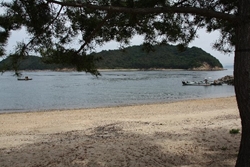
Then, take a bus from the sea station and head to Naoshima Fishing Park. There are few bus stops at Tsuri Park, so you will get off in front of the home town of Tsutsujiso and walk about 10 minutes along the mountain road to reach the beach. Here you can also see a solar salt plant. This fishing park is run by the town with fixed piers, fishing rafts, and fishing grounds. In addition, from May to November you can enjoy fishing for sea bream. In summer, you can catch sea bream, sea bream, vera, scallop, sea bass, scorpionfish, pearl oyster, flounder, mullet, etc. Last year, the bream was released from flounder this year. Expectations will increase with photos of the big fish caught here and fish cultivation. Even if you go empty-handed, it is said that there are rental fishing rods and food available, so travelers can enjoy fishing casually.
One of the most popular items here is the lunch menu “Sea bream sashimi set meal” limited to weekends and holidays (May to October). Plenty of fresh sea bream sashimi, very reasonable (5 yen as of June 10). Reservations are recommended as the number is limited. He also said that he could cook (and pay) the snapper he caught on the spot.


Also famous is the sea bream “Hamayaki”. Wrap the freshly caught sea bream with a straw and steam it in a pan with coarse salt and seawater. You can taste the exquisite saltiness, soft and slightly sweet bream white. This sea bream is also sent as souvenirs and gifts, so you can enjoy Naoshima's feast from a distance.
The day I visited was a weekday, and there was a person sitting on a bench. If you look closely, you are caring for seaweed. According to the story, we are in the process of removing the garbage collected from the beach and we can make Tokoroten. It is sold as a souvenir with tokoroten recipes at fishing parks and sea stations. The seaweed called "Igisu" is harvested on the coast of Naoshima in July and August. This is a local dish that is eaten with vinegar and miso, but recently it has hardly been made.
From 7:18 to 17:XNUMX (until XNUMX:XNUMX in winter), fishing is possible at night on water and soil.
Telephone 087-892-2891
Thorough safety management "Naoshima Hamachi"
Of course, Naoshima is a place where fishery is thriving, and a variety of fish that can be caught in fishing parks are landed. In addition, aquaculture is thriving, and in addition to laver farming, amberjack, hiramasa, thailand, sea bass, flounder, tiger puffer, etc. are raised. What is in the limelight now is “cultivation of hamachi”. In order for consumers to eat safe and delicious hamachi with peace of mind, we have created a strict culture manual and conducted sample tests. In addition, the breeding history is disclosed as a product resume so that you can understand when and how the hamachi was cultured when it was shipped. Naoshima Fisheries Co., Ltd.'s “Naoshima Hamachi” is growing in popularity due to its thorough safety management.
Artistic memories "Benesse House"
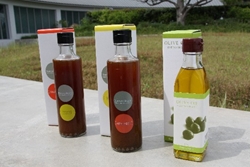

At the Setouchi Triennale, the most noteworthy is the Benesse Art Site Naoshima. Naoshima's rustic nature is dotted with buildings of contemporary art and famous architects, creating a special place that is nowhere else. The core facility, Benesse House, is a facility that combines the functions of an art museum and a hotel, designed by Tadao Ando. Not only in the museum, but also in the garden and on the coast, there are works of contemporary art scattered around, creating a mysterious atmosphere. There are also restaurants ("Museum Restaurant Japanese Cuisine Issen" and "Terrace Restaurant"), cafes (Museum Cafe), spas, shops, etc. that can be used by guests as well.
From there, I visited the "Benesse House Shop" attached to the park building. Here you will find an exhibition catalog on Naoshima, hotel goods with logos, original products of restaurants and art-related goods with a focus on design. And the push of this summer is a T-shirt designed by Katsuhiko Hibino made to commemorate the 55th anniversary of the founding of Benesse. There are also men's, women's, and children's, and the coordination with the family is also OK, and it is in a stylish Naoshima limited BOX (limited quantity). Benesse House Restaurant's specialty dressing is a health-oriented non-oil type (limited quantity) that contains plenty of citrus juice organically grown in Setouchi. The original olive oil, which also uses Shodoshima olives, can be enjoyed directly on bread with a light flavor.
Kashiko, a Japanese sweet that looks like a small piece of art, was born from a wooden form of Edo era that was quietly sleeping in an old candy storehouse, using `` wasanbon, '' a sugar like awasetsu. . It looks like Naoshima's beach shells. However, when included in the mouth, you can enjoy the finest sweetness including minerals and the best meltability in the mouth.
From the rich art site "Chichu Art Museum" to Honmura
On the hill south of the island is the Chichu Art Museum designed by Tadao Ando. Here, works by Claude Monet, Walter de Maria, and James Turrell merge with architectural space to create a giant art piece. This underground store stores original art goods, underground tea, cookies and jams.
On June 6, the museum of Korean contemporary artist Lee Ufan opened at the midpoint between the Chichu Art Museum and the Benesse House Museum. In line with this, the route and operation schedule of the municipal bus have been revised, and a free shuttle bus of Benesse from Atsuji-so will return to and from the terrace restaurant, Benesse House Museum, Lee Ufan Museum and Chichu Art Museum (Setouchi International Art Festival) During the period, 15 flights a day in principle, and every 1 minutes on Saturdays, Sundays and August to September). Then, take the municipal bus in front of Azalea Villa and head to Honmura next. There are nostalgic houses and a permanent art project called “House Project”.
■ If you pull the pull tab ...

Then, get off the bus at the front of the agricultural cooperative in Honmura and explore the area. Recently, fashionable cafes and shops have been born one after another in this area.
The first thing I visited was "Yachiza" in an alley near the bus stop. This is an empty can art shop. From that empty can, you'll see for a while whether such a stylish doll can be made. The name of the shop used to be that the ancestor Yoichi Saemon had a play in the play, and that name was called "Yoichiza", which seems to have been handed down for generations. Speaking of which, the houses in Honmura have a name, and even a map of the name. Dolls that initially had no legs have recently become more and more smart, with their legs growing. Dolls are evolving steadily from hat upgrades and conversations at storefronts. According to her husband, "I was collecting pull tabs for charity, and when I saw the raised surface, my face came up." It seemed to be a souvenir when it was thought of as a small shop decoration. Empty can dolls loved by people on the island. Do you not get along well?
Unique guesthouses and cafes

On the left 30 km east of the bus stop in front of the agricultural cooperative is Ishii Shoten and its cafeteria. An old private house that has been built for over a hundred years is the inn. This will stop your pet with you. There is also a building where you can prepare your own meals, and at lunchtime there will be a cafeteria where you can taste the noodles.

After going along the road in front of the bus stop, behind Ishii Shoten, you will arrive in front of the fine gate of "Saryo Omiyake". During the Tenri period, it was a shrine and a village office serving Kurashiki. Nagayamon and the main house are tangible cultural properties registered by the Agency for Cultural Affairs, and are now being converted into cafes and restaurants. You can also stay here in the main house or guest house.
Currently, Naoshima has about 22 accommodations, such as guesthouses, in Honmura, Miyaura, and Sekiura. There is a list on the Naoshima Tourism Association's home page, "Naoshima of the real face," so please use it.
The world's designer fan

One of the shops that opened this year in this main village is "Marugame Uchiwaya".Next to it is "Cafe Maruya", and a red uchiwa sign is in the alley.At the antenna shop of the Kagawa Prefecture Fan Cooperative Association, you can see a lot of colorful fans.A fan that is also interesting to overseas customers.Famous designer fans are also displayed, and there are demonstrations by craftsmen on weekends, and on Sundays, artists who draw caricatures on white fans come to the store.A fan for me will be completed.
Glass magician

This time, we will visit "Glass Charmer", a little bit away from the center of Honmura. The name of this shop means "glass magician", and beautiful dragonfly balls were lined up in the case inside the shop. If you make a reservation, you can also experience glass crafts. In addition, this is a hideaway café, and if you make a reservation, you can prepare lunch, dinner, and lunch with up to 30 homemade fresh vegetables. Handmade cookies are also crispy and delicious. Recommended for snacks.
Eco-island Naoshima where the golden island is born
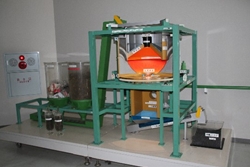
Naoshima has long been called the island of smelting. In 1917, Mitsubishi Joint Stock Company established "Naoshima Smelter" as Mitsubishi's central smelter, and copper production began. Copper smelting, which has a history of nearly 100 years, has now introduced a revolutionary continuous copper smelting method that is environmentally friendly and has achieved significant energy savings.In 2004, we started operation of a valuable metal recycling facility.Metals are recovered from scrap and reused as raw materials for copper smelting.In addition, gold, silver, platinum, etc. are recovered from the slime produced in the copper manufacturing process.Gold and silver are bare metals with a purity of 99.99% or higher, and are widely used in the electronic industry and jewelry.Naoshima is now attracting attention as an island that produces gold. You can also tour this factory facility on the "PLANT Tour" and "Eco Tour".

On the premises of the Naoshima Smelter and Refinery, Mitsubishi Materials Co., Ltd. has the Kagawa Prefectural Naoshima Environmental Center. Things are recycled, and a complete recycling system has been realized. For example, molten slag is subjected to safety inspections and quality inspections, and is effectively used as aggregate for concrete in public works projects in Kagawa Prefecture. This environmental center is open for visitors to visit, and you can easily learn about the waste disposal sites using panels and miniature models of rotary surface melting furnaces. In addition, there is a "Naoshima slag pottery experience workshop" where you can experience pottery using the slag near Miyaura Port, and courses such as soil twisting and painting are carried out.
007 also coming to Naoshima?


"007", which is quite familiar in movies.Naoshima appears under his real name in the novel "The Man with the Red Tales".Therefore, "007 Red Tasting Man Memorial Hall" was born in hopes of making this story into a movie and filming Naoshima.The adjacent "RIEN" is a coffee shop where you can find various handmade miscellaneous goods.Let's stick to grinding coffee from beans.The husband has a career of making paper clay dolls for many years, and pretty doll works are also displayed in the store.

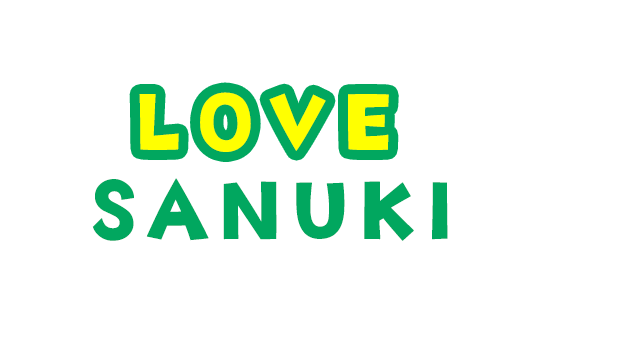














 Olive products from Kagawa Prefecture
Olive products from Kagawa Prefecture
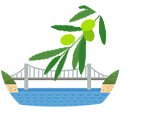



 Stores handling olive-related products
Stores handling olive-related products





